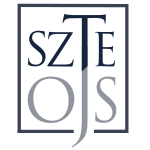Submission
Thank you for your interest in publishing a paper in Különbség. Please carefully study the Journal’s Peer Review process, the Style and Format Guidelines, the Ethics and Malpractice Statement and the Copyright, Licence and Authorial Archiving before submitting your manuscript.
Különbség is published in one volume annually, both in hard copy and online format. The Journal is open access, please study the Open Access Policy.
Manuscripts should be submitted in electronic format, by uploading them to the website of the Journal.
Please upload all three of the following documents:
(1) paper manuscript
(2) short biography of author(s) including full name, academic title and/or degrees, current affiliation(s), ORCID-iD (50-100 words)
(3) an abstract providing a short but comprehensive summary of the paper of about 100-150 words, and 6-8 keywords (both paper and keywords in Hungarian and in English).
Format of all documents: Microsoft Word or OpenOffice.
Name of file: Surname_First substantial word in title_date (without diacritics). Example: kovacs__hume__2019-12-11).
Style and Format Guidelines (download)
The basic format of manuscripts is the following: font type: Times New Roman font, font size: 12 points size, line spacing: 1.5, document format: .doc or .docx file.
Formatting (italics, bold type, etc.) in the main body of text should be limited to the minimum (do not format subtitles). Titles of books and foreign words (in Roman script) are in italics, in brackets after the Hungarian equivalent. Quotes are between quotation marks and are not italicized. Quotes longer than five lines are placed in a separate paragraph, indented both from left and right (1 cm each), in 10 points font size, and without quotation marks. Quotes should be followed by a footnote containing the source with bibliographic data, or these data (in author-date style) should be included in the main text in brackets. (See below.)
Notes and Bibliography
Különbség employs two different systems of citation. Authors are free to adopt any one these, depending on the conventions of the discipline and/or the topic of the paper. The system adopted should be consistently employed all through the manuscript.
1) Classic Style System
Sources are given in footnotes (not endnotes) and the Bibliography as follows:
Book:
Author(s): Title. Number of volume. Trans. Name. Place of publication, Publisher, Year, page numbers.
Example:
Hegel, G. W. F.: Phenomenology of Spirit. Trans. A. V. Miller, Oxford, Oxford University Press, 1977., 10–11.
Article in Book:
Author(s): Title. Trans. Name. In: Name(s) (ed.): Title of Book. Subtitle. Place of publication, Publisher, Year, page number(s).
Example:
Kant, Immanuel: An Answer to the Question: What is Enlightenment? Trans. H. B. Nisbet. In: H. B. Nisbet (ed.): Kant’s Political Writings. Cambridge, Cambridge University Press, 1970.
Article in Journal:
Author(s): Title. Journal. Volume (Year), Issue, page number(s).
Example:
Irwin, T. H.: ’Plato’s Heracliteanism.’ Philosophical Quarterly. 27 (1977) 106, 1–13.
Internet:
Author(s): Title. Link. (Accessed)
Example:
Bergson, Henri: Essai sur les données immédiates de la conscience.
http://classiques.uqac.ca/classiques/bergson_henri/essai_conscience_immediate/essai_conscience.pdf. (Accessed: 2018-12-15).
On first reference in footnote include the full bibliographical data of publication (e.g. Author, Title. Place, etc.).
Subsequent references:
Author’s Surname: I. m. page number(s) (if you use only one source by the author).
Example:
Hegel: I. m. 35.
If you use more than one source by an author, use:
Author’s surname: Abbreviated Title, page number(s).
Example:
Hegel: The Phenomenology of Spirit, 23.
Translations from foreign languages must provide the name of the translator in footnote. Translation by author must be noted by: My translation – Author’s Initials in italics.
Example: My translation – T. P.
Include a full Bibliography at the end of the paper.
2) Author-Date Style System
Sources are given in the main body of the text in brackets as follows: (Marion 2013a, 12.)
Conventional reference for works or abbreviations of standard editions (e.g. Plato: Phaedo 142a–d, Nietzsche: KSA) might be similarly used.
Bibliography:
Book:
Author(s) Year. Title. Place, Publisher.
Example:
Marion, Jean-Luc 2013. Sur la pensée passive de Descartes. Párizs, PUF.
Article in Book:
Author(s) Year. Title. In: Name(s) (ed.): Title. Subtitle. Place, Publisher, page number(s).
Example:
Bergson 2014. L’intuition philosophique. In: uő: La Pensée et le Mouvant. Essais et conférences. Párizs, Flammarion, 117–142.
Article in Journal:
Author(s) Year. Title: Subtitle. Journal Volume. Issue., page number(s).
Example:
Vancamp, Bruno 2002. New Light on an Old Crux: Plato, Philebus 66a8. The Classical Quarterly 52. 1., 388–390.
Translations from foreign languages must provide the name of the translator in footnote. Translation by author must be noted by: My translation – Author’s Initials in italics.
Example: My translation – T. P.
Include a full Bibliography at the end of the paper.
Author Statement
Before submitting a paper, authors should carefully study the Open Access Policy, Peer Review, Submission, Ethics and Malpractice and Copyright sections, and the following Author Statement:
By submitting a paper, author aknowledges and/or declares the following: submitted paper is his/her own, original work in its entirety, and has not been published (either in part or entirely) before, submitted paper complies with the copyright regulations of the Hungarian Copyright Law LXXVI/1999 and bibliographical references comply with Standard MSZ ISO 690, legal handling of copyright issues (suits) to do with the paper are the exclusive legal responsibility of the author of submitted paper, author provides exclusive permission to Különbség to publish and host his/her paper on the website of the paper (www.kulonbségfolyoirat.hu) without claiming any financial benefits from the Journal before, upon or after publication, Különbség upholds the right of a unilateral modification of the conditions of the publication of the paper without requesting prior permission from author, Különbség provides publicity of the conditions of publication on its website, hence author is required to obtain information about and observe any changes.





